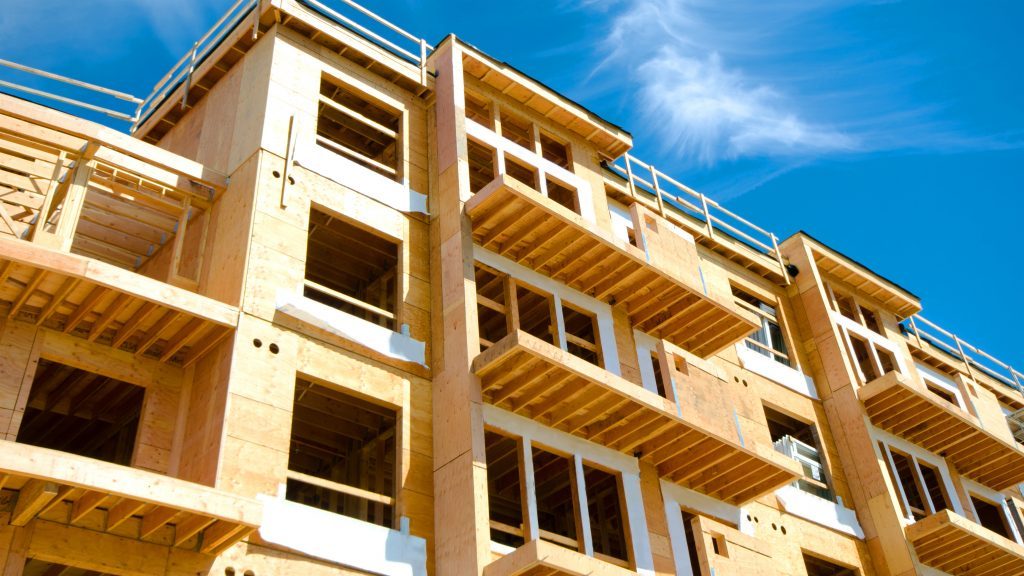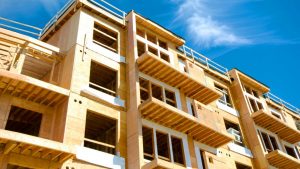The Canadian mass timber industry has been making great strides forward, but it has been kept from growing even faster by challenges it faces in procuring reasonably priced insurance and financing.
Simon Fraser University (SFU) Renewable Cities recently released a guide that describes these challenges.
Titled, Advancing Mass Timber/Risk mitigation and insurance strategies for a thriving sector, the guide presents three what it calls pathways “to help address risks, improve insurability and support a thriving mass timber industry.”
Mass timber’s benefits notwithstanding, projects built with it often face higher insurance rates than traditional materials.
According to the guide, “This can discourage developers from using mass timber elements…Understanding this could influence a phased approach to a building that could make it easier and cheaper to insure.
“It is crucial that the insurance broker negotiating the project understands these specific issues and concerns.”
Guidance and support for the guide was provided by Jeff McLellan, senior vice-president of construction and professional services, BFL Canada Risk and Insurance Services Inc., Norm Couttie of Ecosse Development Corp. and Kelly Walsh, a senior researcher and project manager with SCIUS Advisory.
Walsh moderated a roundtable information gathering session about programs developed by British and Canadian organizations that assess the ability of construction professionals and contractors to work competently with mass timber.
Couttie provided the point of view of a developer.
As president of Adera Development Corporation, Couttie built a six-storey mass timber residential building in Vancouver and a seven-storey mass timber structure in North Vancouver.
Couttie says the biggest threat to mass timber is not fire, as many people believe.
“There have been fire tests, so most insurers know that fire isn’t a big danger; it’s water and moisture,” says Couttie. “Mass timber needs to be guarded from the rain and damp when you’re moving it to the worksite, protected once it’s there and then kept dry when you’re building.”
And once the structure has been erected, it has to be monitored.
“Mass timber doesn’t have a water and moisture track record for brokers and insurers to examine,” says Couttie. “They don’t know how much it costs to rebuild.”
Most of the information that construction insurance brokers and insurers have now is specific to individual projects.
“There haven’t been enough mass-produced buildings constructed yet,” says Couttie. “We’re still in the early state of building with mass timber.”
McLellan says the insurance industry is not likely to embrace mass timber in the near future.
“We still have insurance companies and underwriters who have not moved past their previous experience with light frame, despite that experience being over a decade ago,” says McLellan.
The insurance industry is reactive, he says.
“Underwriters’ decisions are made and supported by tangible evidence from past experience,” says McLellan. “When that experience doesn’t exist, the underwriters will look to their company’s risk control engineers for support. Most are pretty risk averse, and they’re not going to be looking for ways to push boundaries and increase the use of mass timber.”
McLellan says the source of mass timber’s insurance problem is not enough actuarial data and experience.
“If steel reinforced concrete towers were a new thing, the availability and cost of insurance for them would be a lot different than what we currently see in the market,” he says.
The guide puts forward three pathways to address risks in mass timber buildings and construction practices.
Pathway A: Establish a quality assurance program.
By implementing a standardized third-party verification process, the industry can ensure high construction standards and confidence in the performance of mass timber buildings, while also mitigating insurer concerns.
Pathway B: Establish shared protocols and standards.
By defining consistent approaches in the main risk areas, uncertainty for insurers will be reduced and overall project quality improved.
Pathway C: Enhance mass timber training programs.
A structured training framework will give workers, designers and insurers the skills they need to reduce the risk of mass timber construction.
The authors of the guide are Leanne Sawatzky and Rebekah Parker.
To find out more, click here.







Recent Comments